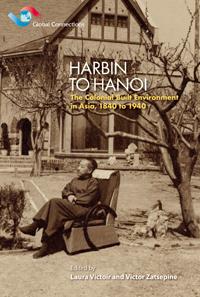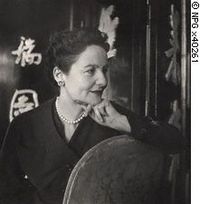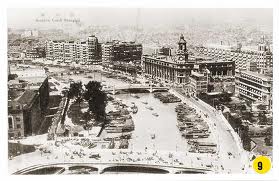Posted: January 4th, 2013 | No Comments »
Harbin to Hanoi: Colonial Built Environment in Asia, 1840 to 1940
Edited by Laura Victoir and Victor Zatsepine

Colonial powers in China and northern Vietnam employed the built environment for many purposes: as an expression of imperial aspirations, a manifestation of supremacy, a mission to civilize, a re-creation of a home away from home, or simply as a place to live and work. In this volume, scholars of city planning, architecture, and Asian and imperial history provide a detailed analysis of how colonization worked on different levels, and how it was expressed in stone, iron, and concrete. The process of creating the colonial built environment was multilayered and unpredictable. This book uncovers the regional diversity of the colonial built form found from Harbin to Hanoi, varied experiences of the foreign powers in Asia, flexible interactions between the colonizers and the colonized, and the risks entailed in building and living in these colonies and treaty ports.
Laura Victoir is a former postdoctoral fellow in European Studies at the University of Hong Kong. She currently teaches in the History Department at Hunter College, City University of New York, specializing in Imperial Russia and in French colonialism in Asia.
Victor Zatsepine is a research assistant professor of history at the University of Hong Kong. He holds degrees from Beijing Language and Culture University, Harvard and the University of British Columbia, and specializes in China’s frontier history and the history of Sino-Russian encounters.
“This volume tells a complex story of conflict, collaboration and co-habitation between actors involved in the unevenness of colonial cities. Central to the volume is architecture and urban form seen as both the text and context for the enactment of power, negotiation and resistance. The contributors have done an excellent job in delivering an interpretive framework that understands colonial cities as a specific site of contestation and identity formation for both the colonizer and the colonized.” — Abidin Kusno, the University of British Columbia
“This well-conceived and truly interdisciplinary volume is a welcome addition to the existing historiography on the colonial built environment in Asia. As the editors note, a focus on the colonial built environment ‘exposes multiple-layers of empire-making and of conquest, both ideological and real.’
Shared connections within this fairly concentrated, compact region with easy access to the sea, as well as differences such as variations in topography and climate the colonizers confronted, are succinctly stated. The book’s regional focus reveals the multiple imperial incursions and processes of colonization by various imperial powers, and the point of revising narratives over-emphasizing the role of the British empire is well taken.” — Haejeong Hazel Hahn, Seattle University
“Harbin to Hanoi is an important cross-disciplinary contribution to the analysis of the built environment in the context of colonial and imperial history in Asia from 1840 to 1940. The editors have collected an impressive collection of essays that provide novel insights into the multiple and varied interaction of colonial powers from Europe and Japan notably in China and northern Indochina. The authors illustrate the diverse actors of colonization both global and local and their impact on built form in different historical context and diverse geographical areas inviting a re-evaluation of the relationship between what is often called the ‘colonizer’ and the ‘colonized’.” — Carola Hein, Bryn Mawr College
Posted: January 4th, 2013 | 1 Comment »
I came across this picture of Nancy Mitford the other day. Now, I must confess, I’m a fan of Nancy and her writing and a bit of a Mitford’s buff really. But I do not know of any links between Nancy and China (or any Mitford and China for that matter). I do know, thanks to Lisa Hilton’s recently published The Horror of Love, about the relationship between Nancy and Free French leader Gaston Palewski, that Pawelski had once dreamed of travelling to Peking and perhaps gaining a position with the French embassy there. But apart from that – nothing. Of course Nancy was friends with a number of people who did spend time in China, notably her friend Harold Acton.
So where is Nancy here? A restaurant, a reception of some sort at an embassy in London or Paris? – the characters behind her are general happiness/celebration characters. A party at a posh Chinese restaurant in the 1950s perhaps? A wedding? A reception for a visiting Chinese writer? I don’t know….
Well, if anyone can shed any light then please let me know?….nice pearls by the way….

Posted: January 3rd, 2013 | No Comments »
I’ve been dabbling around on various tangenital subjects lately – Anna May Wong, London Chinese restaurant culture in the 1930s…s0 today, let’s get back to China, Shanghai to be specific, and some pictures of old Shanghai trolleybuses – the wires remain of course and trolleybuses still plough the streets of the city but all these models are now sadly withdrawn from service…





Posted: January 2nd, 2013 | 1 Comment »
A quick mention for an exhibition – Reclaiming the Edge: Urban Waterways and Civic Engagement – currently running at the Anacostia Community Museum in Washington DC until next September 2013. Urban waterways are of course fascinating and essential and can be done well (think Paris of course with its urban beaches, the revitalised Thames, the rebirth of Manchester’s Ship Canal, Suzhou shady canal-side lanes etc) or not so good (think the mostly dreary canals of Beijing, the lost opportunities in LA etc).
Shanghai is included in this exhibtiion and is, as ever, a tale of two cities – there’s no doubt that Suzhou (Soochow) Creek is a great improvement environmentally on its condition a decade ago (trash, filth, dead dogs etc), yet too much of the creek-side path is blocked, controlled as private land by developers or concreted off for mysterious reasons. Meanwhile Sawgin and other creeks that are essential to Shanghai’s urban waterway system are largely ignored despite their history (Hongkou’s waterways were once major places of commerce and homes for boat dwellers).
Anyway, if you’re near Anacostia pop along – I think they’re exhibiting a fairly rare postcard I had of dragon boats on the Soochow Creek early in the twentieth century which shows that the Creek was, as well as a home for some and a commercial thoroughfare, also a place of fun, tradition and entertainment.

Soochow Creek in its glory days…
Reclaiming the Edge: Urban Waterways and Civic Engagement
October 15, 2012 – September 15, 2013
Location: Main Gallery

Based on research by the museum on the history, public use, and attitudes toward the Anacostia River and its watershed and on review of urban waterway developments in Los Angeles, Pittsburgh, Louisville, London, and Shanghai, Reclaiming the Edge explores various issues regarding human interaction with natural resources in an urban setting. It looks at densely populated watersheds and at rivers as barriers to racial and ethnic integration. The exhibition also examines civic attempts to recover, clean up, re-imagine, or engineer urban rivers for community access and use. The opening of this exhibition kicks off the museum’s 45th anniversary.
Posted: January 2nd, 2013 | No Comments »
Talking of Anna May in a couple of posts recently (on the actor Ley On and on her French-English movie Hai-Tang) and listening to some favourite songs on New Year’s Eve I was reminded that Eric Maschwitz, the song writer, around 1936 wrote These Foolish Things for Anna May Wong (lyrics below). What I’d forgotten, much as I love that song, is that Maschwitz wrote the song after having worked in America, had had a rather romantic and deep felt affair with Anna May Wong and then, after it broke up, returned to England to be Head of Variety at the BBC. He missed Anna May terribly (as you would) and it inspired him, in a melancholy moment, to write These Foolish Things.
The song was recently re-recorded and has become well known again thanks to Rod Stewart and I note this version is online with a collage of Anna May images – so as it’s the end of the holidays and its back to wage slavery soon – relax with a little Rod and Anna May Wong…


A cigarette that bears a lipstick’s traces
An airline ticket to romantic places
And still my heart has wings
These foolish things remind me of you
A tinkling piano in the next apartment
Those stumblin’ words that told you what my heart meant
A fairground’s painted swings
These foolish things remind me of you
You came, you saw, you conquered me
When you did that to me
I knew somehow this had to be
The winds of March that make my heart a dancer
A telephone that rings but who’s to answer?
Oh, how the ghost of you clings
These foolish things remind me of you
The scent of smouldering leaves the wail of steamers
Two lovers on the street who walk like dreamers
Oh how the ghost of you clings
These foolish things
Remind me of you
How strange, how sweet, to find you still
These things are dear to me
They seem to bring you so near to me
The sigh of midnight trains in empty stations
Silk stockings thrown aside dance invitations
Oh how the ghost of you clings
These foolish things
Remind me of you
Remind me of you
Remind me of you
Posted: January 1st, 2013 | 1 Comment »
Browsing around film posters the other day for a post on the largely forgotten Chinese-British actor Ley On I noted he had first appeared in 1930 in a Anna May Wong German film Der Weg Zur Schande. I found that Anna May was also in another German film, one I was not aware of, called Hai-Tang, directed by Richard Eichberg, a prolific German film maker, and Jean Kemm, an equally prolific French actor and director. The film was one of those common cross-production (at least until the mid-1930s) between the French and Germans and the film was issued in both a French and English language version. As well as Anna May is starred the French actor Marcel Vibert (a good idea as Vibert spoke excellent English so could work in both languages and had worked in Britain previously, so could talk easily with Anna May).
It seems the Germans and French sought to exploit Anna May’s image created by EA Dupont in the terrific movie Piccadilly in 1929, shot in London. I’ve posted a lot previously on Piccadilly (here and here). Anna May is exoticised to the max and the trick is repeated in the movie posters for Hai-Tang – particularly the third one below which is an almost direct copy of the most famous Piccadilly. Exotic melodrama would be the best way to describe the film.
Anyway, I like the art work – especially the first poster shown here below…



Posted: December 31st, 2012 | No Comments »
The China Daily (so hold your nose on this one obviously) reports that plans are afoot to restore the so-called Soong Mei-Ling (Madame Chiang) Palace in Nanjing. The project should be completed by next October and then the palace will reopen to the public. The building lies in a leafy suburb of Nanjing and was home to Chiang and Mei Ling during the time of the Republican capital being located at Nanking. The building was begun in 1931 and completed in 1934. Though it managed to survive the Japanese occupation the post-49 administration has been less than kind to the building – thoughtless conversions to provide offices for Party functionaries and bureaucrats in part of the compound, a rather awful state-run hotel in another part. Maintenance was minimal, oversight non-existant. However, it was a well built originally to a higher standard than most post-49 structures so has weathered well.
Now, of course, the tricky question – just what damage will the “renovation” do? We’re used of course to renovations not always being overly helpful in China!! However, I’d venture to suggest that Nanjing has done and can do a slightly better job than either Shanghai (pretty awful generally) or Beijing (nothing less than an architectural and historical holocaust to be honest) – the large number of universities and academics there seems to help as well as being somewhat out of the political and investment spotlight. We shall see – a while back I did a round up in a few posts of notable and interesting Nanjing preservation if anyone’s interested (here, here, here, here, here and here The restorers say – “Renovation will faithfully adhere to blueprint of mansion from 1931-34.” but, as ever we’ll have to wait and see.



Posted: December 31st, 2012 | 3 Comments »
Who was Ley On? – the actor mentioned in my post the other day on 1930s London Chinese restaurants. At some point he was famous in London – formally opening the Chop Suey restaurant on Shaftesbury Avenue and Meard Street. He was said to have been in a film with Anna May Wong – and indeed the lucky bugger was!.
Ley On did exist – he’s on IMDB and listed as having been in at least eight films starting with a German film – Der Weg Zur Schande – in 1930. That was one of Anna May Wong’s German films where she went to work with the expressionists after having been a success in London in Piccadilly (of which no more as I’ve gone on about that film and Anna May’s role in it many times on this blog!!). Anna liked pre-Nazi Weimar Germany and, so rumour had it, got it on with both Marlene Dietrich (well who wouldn’t and many references to her and Shanghai Express on this blog over the years too) and Leni Riefenstahl (before she went all Nazi torch parades bonkers!). The film did come out in the UK as The Flame of Love, so audiences would have seen him in London.
Ley On was apparently born in Canton (Guangzhou if you must) in 1890 but settled largely in London – in 1931 he appeared in the film The Boat from Shanghai (a forgettable romance on the high seas pic), a movie also known as Chin China Chinaman.He then appeared in a British vehicle for Charles Laughton called The Beachcomber (1938) from the Somerset Maugham novel. During the war he was obviously in London and did his bit appearing in the Powell & Pressburger patriotic movie 49th Parallel, a movie aimed at getting the reluctant yanks to come and fight fascism – Ley On played an Eskimo!!I’m not sure but I think the only photograph of Ley On I can find is the one below – a still from 49th Parallel with an eskimo in the background, possibly Ley On (but I can’t be sure – he’s not credited in the photo).

In 1942’s forgettable Banana Ridge he played a Chinese “boy” though he’d have been 52 by that point! He carried on appearing in Brit-flicks after the war – in 1947 heading to North Wales (aka the Himalayas!) with Deborah Kerr and Flora Robson for Black Narcissus, another Powell and Pressburger flick and a big hit – certainly his biggest. His last credited film appears to have been in 1950 – The Black Rose – absolute nonsense about Norman archers going to China with an embarrassed looking Orson Welles, Tyrone Power and Jack Hawkins.
I’m sure Ley On must have done other work over his career – theatre I expect. Anyone with any leads please do let me know. Seems to me we have lots more information on Chinese-American actors – major and minor – than those who worked exclusively or largely in the UK. Would be nice to build up a rounder profile.

















